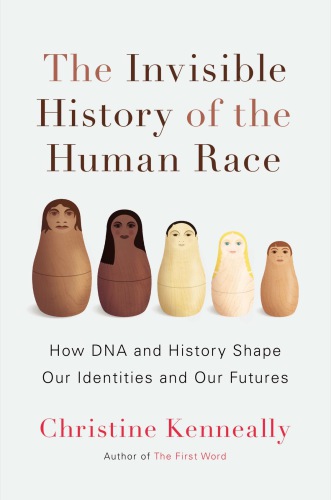
The Invisible History of the Human Race
How DNA and History Shape Our Identities and Our Futures
کتاب های مرتبط
- اطلاعات
- نقد و بررسی
- دیدگاه کاربران
نقد و بررسی

Starred review from August 4, 2014
In captivating prose, journalist Kenneally explores what makes each of us unique. While discussing the critical, but not necessarily determinative, role that DNA plays, Keneally examines the impact environment can have both on a person’s immediate conditions and the long-term influences exerted by cultural factors over many generations. She interviews molecular biologists working to understand how genes influence physical traits, population geneticists attempting to reconstruct the genetic configuration of centuries-old populations, genealogists looking to create family lineages (as well as the principals of companies promoting such searches), and those in charge of the Mormon archive of personal demographic data, the largest of its sort in the world. Kenneally ties these fascinating strands into a complex, powerful, and engaging narrative. She superbly compares and contrasts the related concepts of race and lineage while tackling the ways in which eugenicists and Nazis misunderstood and misused the data available to them. With those abuses in mind, she also confronts the premise that simply making use of such information may be problematic. Kenneally offers a rich, thoughtful blend of science, social science, and philosophy in a manner that mixes personal history with the history of the human species.

September 1, 2014
A soup-to-nuts look at how we can use the tools of genealogy, family stories, cultural history and genetics to gain insight into our own lives and the world in which we live.Kenneally (The First Word: The Search for the Origins of Language, 2007), a freelance journalist whose essays have appeared in the New Yorker, the New York Times and New Scientist, successfully attempts a "synthesis between the ways we consider genes and health, genes and culture, genes and history, genes and race and genes and special traits." Genealogical research has become a popular pastime, with records easily available online. The author uses her Australian family as a jumping-off point, beginning with her father's evident discomfort in discussing his own family history. She discovered that her ancestors-like many of the first white settlers of Australia-were convicts transported there from Britain. It was "a unique social and economic experiment," she writes. While serving their sentences, many "became educated...and once released, they became teachers, surgeons and lawyers and rose to positions of power in the government." The abundant resources and scarcity of labor created opportunities for their rehabilitation, and their progeny showed no predisposition to criminality. Kenneally illustrates how the intersection of genetic information with family histories and census data can engender surprising (and sometimes unsettling) results-e.g., the identification of a modern American descendant of Genghis Khan. The author reveals a curious twist in the saga of the Woodsons, a black family who proudly traced their descent to Thomas Jefferson and his slave mistress, Sally Hemings. Through their efforts, the Hemings-Jefferson relationship was established, but genetic testing proved that their family, who were descendants of Hemings' first son, had a different father. A lively, informative mix of genealogy and genetics.
COPYRIGHT(2014) Kirkus Reviews, ALL RIGHTS RESERVED.

October 1, 2014
According to science, language, and culture journalist Kenneally (The First Word), heredity can explain heritage, predict health, and chart human interrelatedness and deep history. In vignettes starring outstanding individuals, Kenneally explains how DNA traces mass migrations; the cultural wound of slavery bleeds across generations; and big genealogical data restores branches to family trees. The author refreshingly elucidates DNA and genetic recombination with metaphor rather than scientific jargon. Sadly, however, Kenneally falters when discussing gene frequency without using mathematics. She blames consanguinity for recessive lethal conditions rather than explaining that extremely large numbers of matings eventually, inevitably produce offspring with two copies of a defective gene. Worse yet, the author overlooks 21st-century eugenics, which shows up in the selection of ideal gamete donors; China's one-child policy; and possibly in efforts at genetic enhancement. VERDICT Those interested in learning basic human genetics or seeking a more accurate story of eugenics might prefer Ricki Lewis's Human Genetics: The Basics or Paul A. Lombardo's A Century of Eugenics in America. For appreciating genealogy and family history in a new light, Kenneally's work shines.--Eileen H. Kramer, Georgia Perimeter Coll. Lib., Clarkston
Copyright 2014 Library Journal, LLC Used with permission.

























دیدگاه کاربران